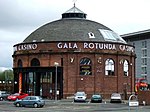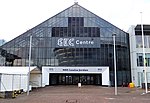Finnieston Crane
Category A listed buildings in GlasgowCranes on the River ClydeIndividual cranes (machines)Industrial buildings completed in 1931Shipyard cranes ... and 2 more
Tourist attractions in GlasgowUse British English from December 2016

The Finnieston Crane or Stobcross Crane is a disused giant cantilever crane in the centre of Glasgow, Scotland. It is no longer operational, but is retained as a symbol of the city's engineering heritage. The crane was used for loading cargo, in particular steam locomotives, onto ships to be exported around the world. It is one of four such cranes on the River Clyde, a fifth one having been demolished in 2007, and one of only eleven giant cantilever cranes remaining worldwide.
Excerpt from the Wikipedia article Finnieston Crane (License: CC BY-SA 3.0, Authors, Images).Finnieston Crane
Congress Road, Glasgow Finnieston
Geographical coordinates (GPS) Address Nearby Places Show on map
Geographical coordinates (GPS)
| Latitude | Longitude |
|---|---|
| N 55.85782 ° | E -4.2862 ° |
Address
Congress Road
G3 8GS Glasgow, Finnieston
Scotland, United Kingdom
Open on Google Maps











